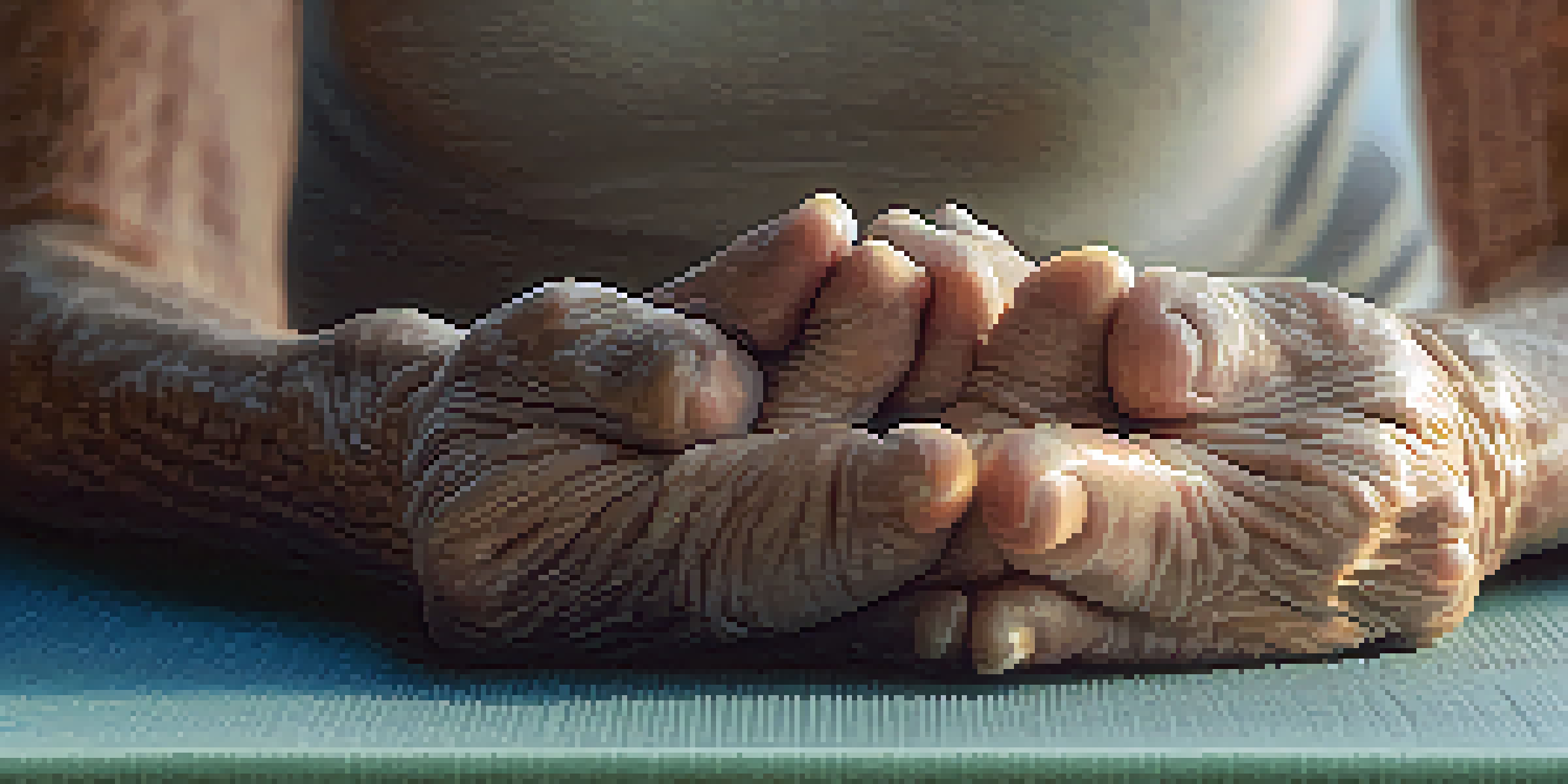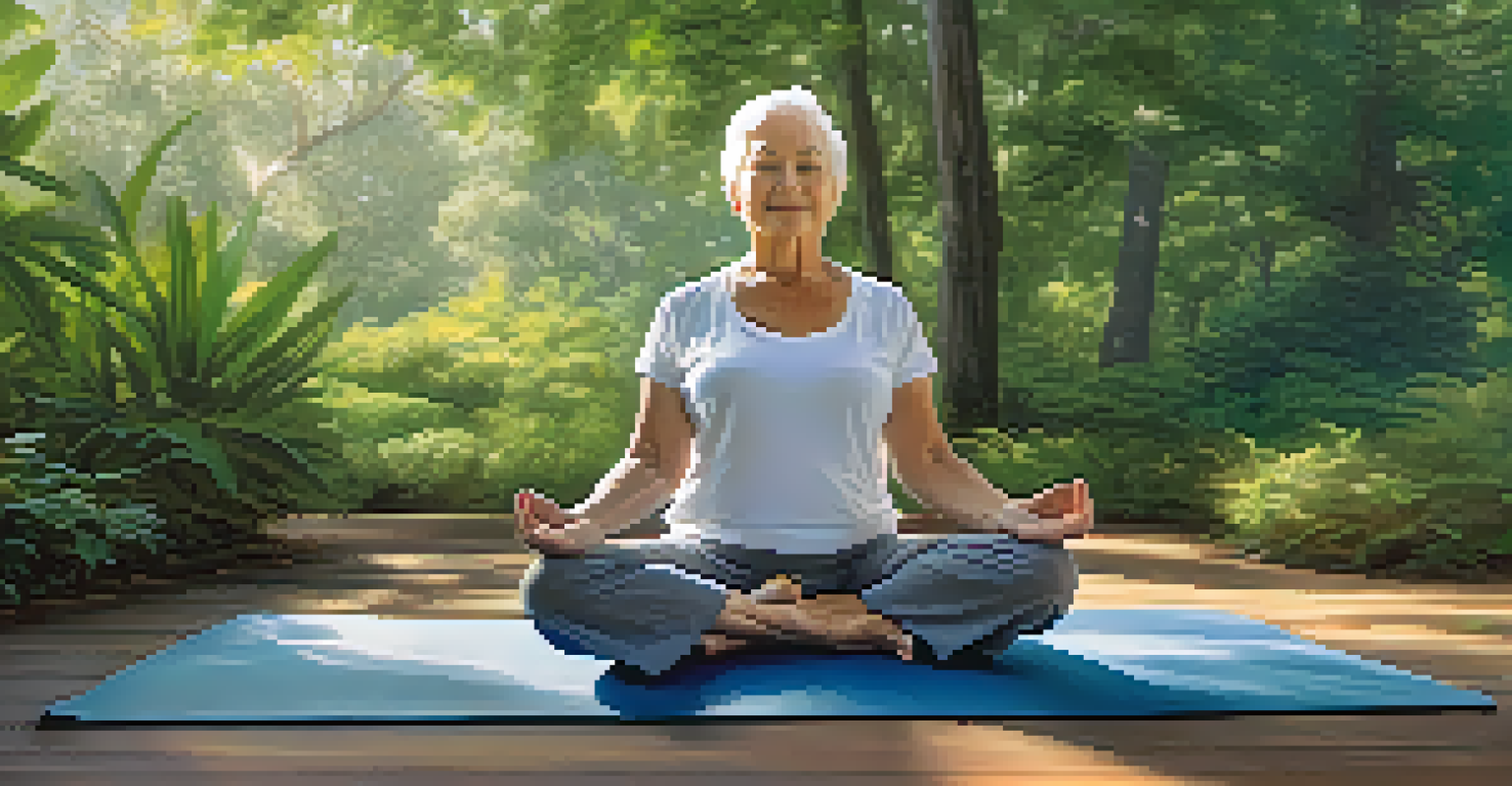How Yoga Supports Balance and Stability in Older Adults

Understanding Balance and Stability in Older Adults
As we age, maintaining balance and stability becomes increasingly vital. Balance refers to the ability to maintain the body's center of gravity over its base, while stability involves controlling that balance during movement. This is crucial for preventing falls, which are a common concern for older adults. By understanding these concepts, we can appreciate how activities like yoga can assist in enhancing them.
Yoga is the journey of the self, through the self, to the self.
Many factors contribute to balance challenges in older adults, including muscle weakness, joint issues, and changes in vision. These elements can make simple tasks, such as walking or standing, feel more daunting. Yoga, with its focus on body awareness and core strength, offers a practical solution to these challenges. Through regular practice, older adults can improve their physical stability and confidence.
Moreover, engaging in exercises that promote balance is essential for overall health. It not only reduces the risk of falls but also encourages independence in daily activities. This is where yoga shines, as it combines physical postures with mindfulness, fostering both mental and physical stability.
The Role of Yoga in Enhancing Core Strength
Core strength plays a fundamental role in maintaining balance. The core comprises the muscles in your abdomen, lower back, and pelvis, which support your spine and help you stay upright. Yoga poses, like the Boat Pose or Bridge Pose, specifically target these muscles, building strength and stability. This increased core strength translates into improved balance in everyday activities.

In addition to strengthening the core, yoga promotes flexibility, which is equally important for stability. As we age, our muscles and joints can lose some of their elasticity, making it harder to move fluidly. Yoga's gentle stretching and various poses help keep these areas limber, allowing for more controlled and stable movements. A flexible body is a balanced body.
Yoga Boosts Balance and Stability
Engaging in yoga helps older adults improve their balance and stability, reducing fall risk and enhancing independence.
Furthermore, the mind-body connection fostered through yoga practice enhances awareness of one’s body position in space. This awareness helps older adults recognize when they may be losing balance, allowing them to adjust accordingly. Thus, yoga not only strengthens but also educates practitioners on how to maintain their physical equilibrium.
Yoga Poses That Improve Balance
Certain yoga poses are particularly effective in enhancing balance for older adults. Poses like Tree Pose and Warrior III require focus and stability, making them excellent choices for improving coordination. These standing poses encourage the body to engage various muscle groups, strengthening both the legs and core, while also challenging the mind to maintain focus.
Balance is not something you find, it's something you create.
Chair Pose is another great option, as it mimics the action of sitting down while engaging the muscles needed for balance. This pose can be modified to suit different abilities, ensuring that everyone can participate and benefit. By incorporating these poses into a regular practice, older adults can gradually build their balance and stability over time.
Additionally, using props like a chair or wall for support can make practicing these poses more accessible. This encourages older adults to explore their limits safely while reaping the benefits of balance training. Yoga's adaptability is a key factor in engaging older individuals in a practice that suits their unique needs.
Breath Control and Its Impact on Balance
Breath control, or pranayama, is a vital aspect of yoga that contributes to improved balance. By focusing on breath, practitioners can cultivate a sense of calm and centeredness, which is essential for maintaining stability. Controlled breathing helps slow down the heart rate and promotes relaxation, allowing the body to respond better to balance challenges.
As older adults practice breath control, they also learn to synchronize their movements with their breath. This mindfulness fosters a deeper awareness of their body, enhancing their ability to maintain balance during transitions between poses. Such fluidity not only improves physical stability but also reduces the risk of falls.
Core Strength Enhances Daily Balance
Strengthening the core through yoga poses directly contributes to better balance and stability in everyday activities.
Moreover, breath control can serve as a tool for managing anxiety or fear associated with falling. By incorporating deep, calming breaths into their practice, older adults can feel more grounded and secure, further bolstering their confidence in maintaining balance in various situations.
Mindfulness and Focus in Yoga Practice
Mindfulness, a core principle of yoga, plays a significant role in enhancing balance and stability. By encouraging practitioners to focus on the present moment, yoga helps older adults become more aware of their body and movements. This heightened awareness is crucial for recognizing shifts in balance and making necessary adjustments.
Incorporating mindfulness into yoga practice also helps reduce distractions that can lead to instability. Older adults can learn to tune into their body’s signals, understanding when to engage certain muscles or shift their weight. This mental clarity not only improves physical balance but also enhances overall well-being.
Furthermore, practicing mindfulness can alleviate anxiety related to balance issues. When older adults feel more at ease and centered, they are less likely to experience the fear of falling. This confidence allows them to engage more fully in their yoga practice and daily life, fostering a greater sense of stability overall.
The Social Benefits of Group Yoga Classes
Joining a group yoga class can offer more than just physical benefits; it also fosters a sense of community and support. For older adults, participating in group classes can combat feelings of isolation and loneliness, which can negatively impact mental health. Having a supportive community encourages regular practice, which is essential for maintaining balance and stability.
Group classes also provide a safe environment for older adults to explore their abilities and limits. Instructors can offer personalized modifications to poses, ensuring everyone feels included and challenged at the same time. This encouragement can lead to improved confidence and motivation to continue practicing yoga.
Mindfulness Reduces Fall Anxiety
Practicing mindfulness in yoga fosters body awareness, helping older adults manage anxiety related to balance and falls.
Additionally, sharing experiences and learning from peers can enhance the overall yoga experience. Older adults can exchange tips, stories, and encouragement, reinforcing their commitment to improving balance and stability through yoga. This social aspect adds a layer of enjoyment that makes regular practice more appealing.
Creating a Safe Yoga Practice at Home
For those who prefer practicing yoga at home, creating a safe environment is paramount. Begin by choosing a clear, clutter-free space where you can move freely without the risk of tripping. Using props like mats, blocks, or straps can provide extra support and stability during practice, making it easier to perform poses safely.
It's also essential to listen to your body and choose poses that feel comfortable. Older adults should focus on their limits and gradually increase the difficulty of their practice over time. Online classes or instructional videos can offer guidance and help ensure that they are practicing safely and effectively.

Lastly, establishing a consistent routine can promote the long-term benefits of yoga. A regular practice not only enhances balance and stability but also encourages relaxation and mindfulness. By committing to a safe and enjoyable practice, older adults can significantly improve their overall well-being.